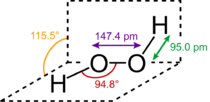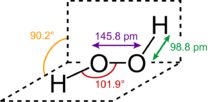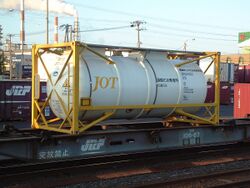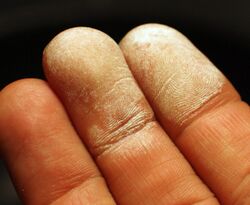Chemistry:Hydrogen peroxide

| |||
| |||
| Names | |||
|---|---|---|---|
| IUPAC name
Hydrogen peroxide
| |||
| Systematic IUPAC name
Peroxol | |||
| Other names
Dioxidane
Oxidanyl Perhydroxic acid 0-hydroxyol Oxygenated water Peroxaan | |||
| Identifiers | |||
3D model (JSmol)
|
|||
| ChEBI | |||
| ChEMBL | |||
| ChemSpider | |||
| EC Number |
| ||
| KEGG | |||
PubChem CID
|
|||
| RTECS number |
| ||
| UNII | |||
| UN number | 2015 (>60% soln.) 2014 (20–60% soln.) 2984 (8–20% soln.) | ||
| |||
| |||
| Properties | |||
| H2O2 | |||
| Molar mass | 34.014 g·mol−1 | ||
| Appearance | Very light blue liquid | ||
| Odor | slightly sharp | ||
| Density | 1.11 g/cm3 (20 °C, 30% (w/w) solution)[1] 1.450 g/cm3 (20 °C, pure) | ||
| Melting point | −0.43 °C (31.23 °F; 272.72 K) | ||
| Boiling point | 150.2 °C (302.4 °F; 423.3 K) (decomposes) | ||
| Miscible | |||
| Solubility | soluble in ether, alcohol insoluble in petroleum ether | ||
| log P | -0.43[2] | ||
| Vapor pressure | 5 mmHg (30 °C)[3] | ||
| Acidity (pKa) | 11.75 | ||
| −17.7·10−6 cm3/mol | |||
Refractive index (nD)
|
1.4061 | ||
| Viscosity | 1.245 cP (20 °C) | ||
| 2.26 D | |||
| Thermochemistry | |||
Heat capacity (C)
|
1.267 J/(g·K) (gas) 2.619 J/(g·K) (liquid) | ||
Std enthalpy of
formation (ΔfH⦵298) |
−187.80 kJ/mol | ||
| Pharmacology | |||
| 1=ATC code }} | A01AB02 (WHO) D08AX01 (WHO), D11AX25 (WHO), S02AA06 (WHO) | ||
| Hazards | |||
| Safety data sheet | ICSC 0164 (>60% soln.) | ||
| GHS pictograms |   
| ||
| GHS Signal word | danger | ||
| H271, H302, H314, H332, H335, H412 | |||
| P280, P305+351+338, P310 | |||
| NFPA 704 (fire diamond) | |||
| Flash point | Non-flammable | ||
| Lethal dose or concentration (LD, LC): | |||
LD50 (median dose)
|
1518 mg/kg 2000 mg/kg (oral, mouse)[4] | ||
LC50 (median concentration)
|
1418 ppm (rat, 4 hr)[4] | ||
LCLo (lowest published)
|
227 ppm (mouse)[4] | ||
| NIOSH (US health exposure limits): | |||
PEL (Permissible)
|
TWA 1 ppm (1.4 mg/m3)[3] | ||
REL (Recommended)
|
TWA 1 ppm (1.4 mg/m3)[3] | ||
IDLH (Immediate danger)
|
75 ppm[3] | ||
| Related compounds | |||
Related compounds
|
Water Ozone Hydrazine Hydrogen disulfide Dioxygen difluoride | ||
Except where otherwise noted, data are given for materials in their standard state (at 25 °C [77 °F], 100 kPa). | |||
| Infobox references | |||
Hydrogen peroxide is a chemical compound with the formula H
2O
2. In its pure form, it is a very pale blue[5] liquid that is slightly more viscous than water. It is used as an oxidizer, bleaching agent, and antiseptic, usually as a dilute solution (3%–6% by weight) in water for consumer use, and in higher concentrations for industrial use. Concentrated hydrogen peroxide, or "high-test peroxide", decomposes explosively when heated and has been used both as a monopropellant and an oxidizer in rocketry.[6]
Hydrogen peroxide is a reactive oxygen species and the simplest peroxide, a compound having an oxygen–oxygen single bond. It decomposes slowly into water and elemental oxygen when exposed to light, and rapidly in the presence of organic or reactive compounds. It is typically stored with a stabilizer in a weakly acidic solution in an opaque bottle. Hydrogen peroxide is found in biological systems including the human body. Enzymes that use or decompose hydrogen peroxide are classified as peroxidases.
Properties
The boiling point of H
2O
2 has been extrapolated as being 150.2 °C (302.4 °F), approximately 50 °C (90 °F) higher than water. In practice, hydrogen peroxide will undergo potentially explosive thermal decomposition if heated to this temperature. It may be safely distilled at lower temperatures under reduced pressure.[7]
Hydrogen peroxide forms stable adducts with urea (Hydrogen peroxide - urea), sodium carbonate (sodium percarbonate) and other compounds.[8] An acid-base adduct with triphenylphosphine oxide is a useful "carrier" for H
2O
2 in some reactions.
Structure
Hydrogen peroxide (H
2O
2) is a nonplanar molecule with (twisted) C2 symmetry; this was first shown by Paul-Antoine Giguère in 1950 using infrared spectroscopy.[9][10] Although the O−O bond is a single bond, the molecule has a relatively high rotational barrier of 386 cm−1 (4.62 kJ/mol) for rotation between enantiomers via the trans configuration, and 2460 cm−1 (29.4 kJ/mol) via the cis configuration.[11] These barriers are proposed to be due to repulsion between the lone pairs of the adjacent oxygen atoms and dipolar effects between the two O–H bonds. For comparison, the rotational barrier for ethane is 1040 cm−1 (12.4 kJ/mol).
The approximately 100° dihedral angle between the two O–H bonds makes the molecule chiral. It is the smallest and simplest molecule to exhibit enantiomerism. It has been proposed that the enantiospecific interactions of one rather than the other may have led to amplification of one enantiomeric form of ribonucleic acids and therefore an origin of homochirality in an RNA world.[12]
The molecular structures of gaseous and crystalline H
2O
2 are significantly different. This difference is attributed to the effects of hydrogen bonding, which is absent in the gaseous state.[13] Crystals of H
2O
2 are tetragonal with the space group D44 or P41212.[14]
Aqueous solutions
In aqueous solutions, hydrogen peroxide forms a eutectic mixture, exhibiting freezing-point depression down as low as -56 °C; pure water has a freezing point of 0 °C and pure hydrogen peroxide of -0.43 °C. The boiling point of the same mixtures is also depressed in relation with the mean of both boiling points (125.1 °C). It occurs at 114 °C. This boiling point is 14 °C greater than that of pure water and 36.2 °C less than that of pure hydrogen peroxide.[15]

2O
2 and water: Area above blue line is liquid. Dotted lines separate solid–liquid phases from solid–solid phases.
| H 2O 2 (w/w) |
Density (g/cm3) |
Temp. (°C) |
|---|---|---|
| 3% | 1.0095 | 15 |
| 27% | 1.10 | 20 |
| 35% | 1.13 | 20 |
| 50% | 1.20 | 20 |
| 70% | 1.29 | 20 |
| 75% | 1.33 | 20 |
| 96% | 1.42 | 20 |
| 98% | 1.43 | 20 |
| 100% | 1.45 | 20 |
Hydrogen peroxide is most commonly available as a solution in water. For consumers, it is usually available from pharmacies at 3 and 6 wt% concentrations. The concentrations are sometimes described in terms of the volume of oxygen gas generated; one milliliter of a 20-volume solution generates twenty milliliters of oxygen gas when completely decomposed. For laboratory use, 30 wt% solutions are most common. Commercial grades from 70% to 98% are also available, but due to the potential of solutions of more than 68% hydrogen peroxide to be converted entirely to steam and oxygen (with the temperature of the steam increasing as the concentration increases above 68%) these grades are potentially far more hazardous and require special care in dedicated storage areas. Buyers must typically allow inspection by commercial manufacturers.
Comparison with analogues
Hydrogen peroxide has several structural analogues with H
mX–XH
n bonding arrangements (water also shown for comparison). It has the highest (theoretical) boiling point of this series (X = O, S, N, P). Its melting point is also fairly high, being comparable to that of hydrazine and water, with only hydroxylamine crystallising significantly more readily, indicative of particularly strong hydrogen bonding. Diphosphane and hydrogen disulfide exhibit only weak hydrogen bonding and have little chemical similarity to hydrogen peroxide. Structurally, the analogues all adopt similar skewed structures, due to repulsion between adjacent lone pairs.
| Name | Formula | Molar mass (g/mol) |
Melting point (°C) |
Boiling point (°C) |
|---|---|---|---|---|
| Water | HOH | 18.02 | 0.00 | 99.98 |
| Hydrogen peroxide | HOOH | 34.01 | −0.43 | 150.2* |
| Hydrogen disulfide | HSSH | 66.15 | −89.6 | 70.7 |
| Hydrazine | H2NNH2 | 32.05 | 2 | 114 |
| Hydroxylamine | NH2OH | 33.03 | 33 | 58* |
| Diphosphane | H2PPH2 | 65.98 | −99 | 63.5* |
Natural occurrence
Hydrogen peroxide is produced by various biological processes mediated by enzymes.
Hydrogen peroxide has been detected in surface water, in groundwater, and in the atmosphere. It forms upon illumination of water.[citation needed] Sea water contains 0.5 to 14 μg/L of hydrogen peroxide, and freshwater contains 1 to 30 μg/L.[16] Concentrations in air are about 0.4 to 4 μg/m3, varying over several orders of magnitude depending in conditions such as season, altitude, daylight and water vapor content. In rural nighttime air it is less than 0.014 μg/m3, and in moderate photochemical smog it is 14 to 42 μg/m3.[17]
The amount of hydrogen peroxide in biological systems can be assayed using a fluorometric assay.[18]
Discovery
Alexander von Humboldt is sometimes said to have been the first to report the first synthetic peroxide, barium peroxide, in 1799 as a by-product of his attempts to decompose air, although this is disputed due to von Humboldt's ambiguous wording.[19] Nineteen years later Louis Jacques Thénard recognized that this compound could be used for the preparation of a previously unknown compound, which he described as eau oxygénée ("oxygenated water") – subsequently known as hydrogen peroxide.[20][21][22]
An improved version of Thénard's process used hydrochloric acid, followed by addition of sulfuric acid to precipitate the barium sulfate byproduct. This process was used from the end of the 19th century until the middle of the 20th century.[23]
The bleaching effect of peroxides and their salts on natural dyes had been known since Thénard's experiments in the 1820s, but early attempts of industrial production of peroxides failed. The first plant producing hydrogen peroxide was built in 1873 in Berlin. The discovery of the synthesis of hydrogen peroxide by electrolysis with sulfuric acid introduced the more efficient electrochemical method. It was first commercialized in 1908 in Weißenstein, Carinthia, Austria. The anthraquinone process, which is still used, was developed during the 1930s by the German chemical manufacturer IG Farben in Ludwigshafen. The increased demand and improvements in the synthesis methods resulted in the rise of the annual production of hydrogen peroxide from 35,000 tonnes in 1950, to over 100,000 tonnes in 1960, to 300,000 tonnes by 1970; by 1998 it reached 2.7 million tonnes.[16]
Early attempts failed to produce neat hydrogen peroxide. Anhydrous hydrogen peroxide was first obtained by vacuum distillation.[24]
Determination of the molecular structure of hydrogen peroxide proved to be very difficult. In 1892, the Italian physical chemist Giacomo Carrara (1864–1925) determined its molecular mass by freezing-point depression, which confirmed that its molecular formula is H
2O
2.[25] H
2O=O seemed to be just as possible as the modern structure, and as late as in the middle of the 20th century at least half a dozen hypothetical isomeric variants of two main options seemed to be consistent with the available evidence.[26] In 1934, the English mathematical physicist William Penney and the Scottish physicist Gordon Sutherland proposed a molecular structure for hydrogen peroxide that was very similar to the presently accepted one.[27][28]
Production

In 1994, world production of H
2O
2 was around 1.9 million tonnes and grew to 2.2 million in 2006,[29] most of which was at a concentration of 70% or less. In that year, bulk 30% H
2O
2 sold for around 0.54 USD/kg, equivalent to US$1.50/kg (US$0.68/lb) on a "100% basis"[clarification needed].[30]
Today, hydrogen peroxide is manufactured almost exclusively by the anthraquinone process, which was originally developed by BASF in 1939. It begins with the reduction of an anthraquinone (such as 2-ethylanthraquinone or the 2-amyl derivative) to the corresponding anthrahydroquinone, typically by hydrogenation on a palladium catalyst. In the presence of oxygen, the anthrahydroquinone then undergoes autoxidation: the labile hydrogen atoms of the hydroxy groups transfer to the oxygen molecule, to give hydrogen peroxide and regenerating the anthraquinone. Most commercial processes achieve oxidation by bubbling compressed air through a solution of the anthrahydroquinone, with the hydrogen peroxide then extracted from the solution and the anthraquinone recycled back for successive cycles of hydrogenation and oxidation.[30][31]
The net reaction for the anthraquinone-catalyzed process is :[30]
- H
2 + O
2 → H
2O
2
The economics of the process depend heavily on effective recycling of the extraction solvents, the hydrogenation catalyst and the expensive quinone.
Historical methods
Hydrogen peroxide was once prepared industrially by hydrolysis of ammonium persulfate:
- [NH
4]
2S
2O
8 + 2 H
2O → 2 [NH
4]HSO
4 + H
2O
2
[NH
4]
2S
2O
4 was itself obtained by the electrolysis of a solution of ammonium bisulfate ([NH
4]HSO
4) in sulfuric acid.[32]
Other routes
Small amounts are formed by electrolysis, photochemistry, and electric arc, and related methods.[33]
A commercially viable route for hydrogen peroxide via the reaction of hydrogen with oxygen favours production of water but can be stopped at the peroxide stage.[34][35] One economic obstacle has been that direct processes give a dilute solution uneconomic for transportation. None of these has yet reached a point where it can be used for industrial-scale synthesis.
Reactions
Acid-base
Hydrogen peroxide is about 1000x stronger acid than water.[36]
- H
2O
2 ⇌ H+
+ HO−
2 pK = 11.65
Disproportionation
Hydrogen peroxide disproportionates to form water and oxygen with a ΔHo of –2884.5 kJ/kg[37] and a ΔS of 70.5 J/(mol·K):
- [math]\ce{ 2 H2O2 -> 2 H2O + O2 }[/math]
The rate of decomposition increases with rise in temperature, concentration, and pH. H
2O
2 is unstable under alkaline conditions. Decomposition is catalysed by various redox-active ions or compounds, including most transition metals and their compounds (e.g. manganese dioxide (MnO
2), silver, and platinum).[38]
Oxidation reactions
The redox properties of hydrogen peroxide depend on pH. In acidic solutions, H
2O
2 is a powerful oxidizer.
| Oxidizing reagent |
Reduced product |
Oxidation potential (V) |
|---|---|---|
| F 2 |
HF | 3.0 |
| O 3 |
O 2 |
2.1 |
| H 2O 2 |
H 2O |
1.8 |
| KMnO 4 |
MnO 2 |
1.7 |
| ClO 2 |
HClO | 1.5 |
| Cl 2 |
Cl− |
1.4 |
Sulfite (SO2−
3) is oxidized to sulfate (SO2−
4).
Reduction reactions
Under alkaline conditions, hydrogen peroxide is a reductant. When H
2O
2 acts as a reducing agent, oxygen gas is also produced. For example, hydrogen peroxide will reduce sodium hypochlorite and potassium permanganate, which is a convenient method for preparing oxygen in the laboratory:
- NaOCl + H
2O
2 → O
2 + NaCl + H
2O - 2 KMnO
4 + 3 H
2O
2 → 2 MnO
2 + 2 KOH + 2 H
2O + 3 O
2
The oxygen produced from hydrogen peroxide and sodium hypochlorite is in the singlet state.
Although usually a reductant, alkaline hydrogen peroxide converts Mn(II) to the dioxide:
- H
2O
2 + Mn2+ + 2 OH−
→ MnO
2 + 2 H
2O
In a related reaction, potassium permanganate is reduced to Mn2+ by acidic H
2O
2:[5]
- 2 MnO−
4 + 5 H
2O
2 + 6 H+
→ 2 Mn2+
+ 8 H
2O + 5 O
2
Organic reactions
Hydrogen peroxide is frequently used as an oxidizing agent. Illustrative is oxidation of thioethers to sulfoxides:[39][40]
- [math]\ce{ Ph-S-CH3 + H2O2 -> Ph-S(O)-CH3 + H2O }[/math]
Alkaline hydrogen peroxide is used for epoxidation of electron-deficient alkenes such as acrylic acid derivatives,[41] and for the oxidation of alkylboranes to alcohols, the second step of hydroboration-oxidation. It is also the principal reagent in the Dakin oxidation process.
Precursor to other peroxide compounds
Hydrogen peroxide is a weak acid, forming hydroperoxide or peroxide salts with many metals.
It also converts metal oxides into the corresponding peroxides. For example, upon treatment with hydrogen peroxide, chromic acid (CrO
3 and H
2SO
4) forms a blue peroxide CrO(O
2)
2.
Biochemistry
Production
The aerobic oxidation of glucose in the presence of the enzyme glucose oxidase produces hydrogen peroxide. The conversion affords gluconolactone:[42]
- C
6H
12O
7 + O
2 → C
6H
10O
7 + H
2O
2
Superoxide dismutases (SOD)s are enzymes that promote the disproportionation of superoxide into oxygen and hydrogen peroxide.[43]
- [math]\ce{ 2 O2- + 2 H+ -> O2 + H2O2 }[/math]
- [math]\ce{ 2 H2O2 -> O2 + 2 H2O }[/math]
Peroxisomes are organelles found in virtually all eukaryotic cells.[44] They are involved in the catabolism of very long chain fatty acids, branched chain fatty acids, D-amino acids, polyamines, and biosynthesis of plasmalogens, ether phospholipids, which are found in mammalian brains and lungs.[45] They produce hydrogen peroxide in s process catalyzed by flavin adenine dinucleotide (FAD):[46]
- [math]\ce{ R-CH2-CH2-CO-SCoA + O2 ->[\ce{FAD}] R-CH=CH-CO-SCoA + H2O2 }[/math]
Hydrogen peroxide arises by the degradation of adenosine monophosphate, which yields hypoxanthine. Hypoxanthine is then oxidatively catabolized first to xanthine and then to uric acid, and the reaction is catalyzed by the enzyme xanthine oxidase:[47]
The degradation of guanosine monophosphate yields xanthine as an intermediate product which is then converted in the same way to uric acid with the formation of hydrogen peroxide.[47]
Consumption
Catalase, another peroxisomal enzyme, uses this H
2O
2 to oxidize other substrates, including phenols, formic acid, formaldehyde, and alcohol, by means of a peroxidation reaction:
- [math]\ce{ H2O2 + R'H2 -> R' + 2 H2O }[/math]
thus eliminating the poisonous hydrogen peroxide in the process.
This reaction is important in liver and kidney cells, where the peroxisomes neutralize various toxic substances that enter the blood. Some of the ethanol humans drink is oxidized to acetaldehyde in this way.[48] In addition, when excess H
2O
2 accumulates in the cell, catalase converts it to H
2O through this reaction:
- H
2O
2 → 0.5 O
2 + H
2O
Glutathione peroxidase, a selenoenzyme, also catalyzes the disproportionation of hydrogen peroxide.
Fenton reaction
The reaction of Fe2+ and hydrogen peroxide is the basis of the Fenton reaction, which generates hydroxyl radicals, which are of significance in biology:
- Fe(II) + H
2O
2 → Fe(III)OH + HO ·
The fenton reaction explains the toxicity of hydrogen peroxides because the hydroxyl radicals rapidly and irreversibly oxidize all organic compounds including proteins, membrane lipids, and DNA.[49] Hydrogen peroxide is a significant source of oxidative DNA damage in living cells. DNA damage includes formation of 8-Oxo-2'-deoxyguanosine among many other altered bases, as well as strand breaks, inter-strand crosslinks, and deoxyribose damage.[50] By interacting with Cl¯ hydrogen peroxide also lead to chlorinated DNA bases.[50] Hydroxyl radicals readily damage vital cellular components, especially those of the mitochondria.[51][52][53] The compound is a major factor implicated in the free-radical theory of aging, based on its ready conversion into a hydroxyl radical.
Function
Eggs of sea urchin, shortly after fertilization by a sperm, produce hydrogen peroxide. It is then converted to hydroxyl radicals (HO•), which initiate radical polymerization, which surrounds the eggs with a protective layer of polymer.
The bombardier beetle combine hydroquinone and hydrogen peroxide, leading to a violent exothermic chemical reaction to produce boiling, foul-smelling liquid partially becomes a gas (flash evaporation) and is expelled through an outlet valve with a loud popping sound.[54][55][56]
As a proposed signaling molecule, hydrogen peroxide may regulate of a wide variety of biological processes.[57][58]
At least one study has also tried to link hydrogen peroxide production to cancer.[59]
Uses
Bleaching
About 60% of the world's production of hydrogen peroxide is used for pulp- and paper-bleaching.[29] The second major industrial application is the manufacture of sodium percarbonate and sodium perborate, which are used as mild bleaches in laundry detergents. A representative conversion is:
- Na
2B
4O
7 + 4 H
2O
2 + 2 NaOH → 2 Na
2B
2O
4(OH)
4 + H
2O
Sodium percarbonate, which is an adduct of sodium carbonate and hydrogen peroxide, is the active ingredient in such laundry products as OxiClean and Tide laundry detergent. When dissolved in water, it releases hydrogen peroxide and sodium carbonate.[23] By themselves these bleaching agents are only effective at wash temperatures of 60 °C (140 °F) or above and so, often are used in conjunction with bleach activators, which facilitate cleaning at lower temperatures.
Hydrogen peroxide has also been used as a flour bleaching agent and a tooth and bone whitening agent.
Production of organic peroxy compounds
It is used in the production of various organic peroxides with dibenzoyl peroxide being a high volume example.[60] Peroxy acids, such as peracetic acid and meta-chloroperoxybenzoic acid also are produced using hydrogen peroxide. Hydrogen peroxide has been used for creating organic peroxide-based explosives, such as acetone peroxide. It is used as an initiator in polymerizations. Hydrogen peroxide reacts with certain di-esters, such as phenyl oxalate ester (cyalume), to produce chemiluminescence; this application is most commonly encountered in the form of glow sticks.
Production of inorganic peroxides
The reaction with borax leads to sodium perborate, a bleach used in laundry detergents:
- [math]\ce{ Na2B4O7 + 4 H2O2 + 2 NaOH -> 2 Na2B2O4(OH)4 + H2O }[/math]
Sewage treatment
Hydrogen peroxide is used in certain waste-water treatment processes to remove organic impurities. In advanced oxidation processing, the Fenton reaction[61][62] gives the highly reactive hydroxyl radical (•OH). This degrades organic compounds, including those that are ordinarily robust, such as aromatic or halogenated compounds.[63] It can also oxidize sulfur-based compounds present in the waste; which is beneficial as it generally reduces their odour.[64]
Disinfectant
Hydrogen peroxide may be used for the sterilization of various surfaces,[65] including surgical tools,[66] and may be deployed as a vapour (VHP) for room sterilization.[67] H
2O
2 demonstrates broad-spectrum efficacy against viruses, bacteria, yeasts, and bacterial spores.[68][69] In general, greater activity is seen against Gram-positive than Gram-negative bacteria; however, the presence of catalase or other peroxidases in these organisms may increase tolerance in the presence of lower concentrations.[70] Lower levels of concentration (3%) will work against most spores; higher concentrations (7 to 30%) and longer contact times will improve sporicidal activity.[69][71]
Hydrogen peroxide is seen as an environmentally safe alternative to chlorine-based bleaches, as it degrades to form oxygen and water and it is generally recognized as safe as an antimicrobial agent by the U.S. Food and Drug Administration (FDA).[72]
Propellant
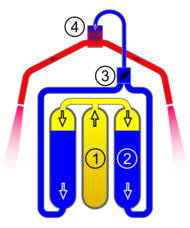
High-concentration H
2O
2 is referred to as "high-test peroxide" (HTP). It can be used either as a monopropellant (not mixed with fuel) or as the oxidizer component of a bipropellant rocket. Use as a monopropellant takes advantage of the decomposition of 70–98% concentration hydrogen peroxide into steam and oxygen. The propellant is pumped into a reaction chamber, where a catalyst, usually a silver or platinum screen, triggers decomposition, producing steam at over 600 °C (1,100 °F), which is expelled through a nozzle, generating thrust. H
2O
2 monopropellant produces a maximal specific impulse (Isp) of 161 s (1.6 kN·s/kg). Peroxide was the first major monopropellant adopted for use in rocket applications. Hydrazine eventually replaced hydrogen-peroxide monopropellant thruster applications primarily because of a 25% increase in the vacuum specific impulse.[73] Hydrazine (toxic) and hydrogen peroxide (less-toxic [ACGIH TLV 0.01 and 1 ppm respectively]) are the only two monopropellants (other than cold gases) to have been widely adopted and utilized for propulsion and power applications. The Bell Rocket Belt, reaction control systems for X-1, X-15, Centaur, Mercury, Little Joe, as well as the turbo-pump gas generators for X-1, X-15, Jupiter, Redstone and Viking used hydrogen peroxide as a monopropellant.[74] The RD-107 engines (used from 1957 to present) in the R-7 series of rockets decompose hydrogen peroxide to power the turbopumps.
In bipropellant applications, H
2O
2 is decomposed to oxidize a burning fuel. Specific impulses as high as 350 s (3.5 kN·s/kg) can be achieved, depending on the fuel. Peroxide used as an oxidizer gives a somewhat lower Isp than liquid oxygen, but is dense, storable, non-cryogenic and can be more easily used to drive gas turbines to give high pressures using an efficient closed cycle. It may also be used for regenerative cooling of rocket engines. Peroxide was used very successfully as an oxidizer in World War II German rocket motors (e.g. T-Stoff, containing oxyquinoline stabilizer, for both the Walter HWK 109-500 Starthilfe RATO externally podded monopropellant booster system, and for the Walter HWK 109-509 rocket motor series used for the Me 163B), most often used with C-Stoff in a self-igniting hypergolic combination, and for the low-cost British Black Knight and Black Arrow launchers. Presently, HTP is used on ILR-33 AMBER[75] and Nucleus[76] suborbital rockets.
In the 1940s and 1950s, the Hellmuth Walter KG–conceived turbine used hydrogen peroxide for use in submarines while submerged; it was found to be too noisy and require too much maintenance compared to diesel-electric power systems. Some torpedoes used hydrogen peroxide as oxidizer or propellant. Operator error in the use of hydrogen-peroxide torpedoes was named as possible causes for the sinking of HMS Sidon and the Russian submarine Kursk.[77] SAAB Underwater Systems is manufacturing the Torpedo 2000. This torpedo, used by the Swedish Navy, is powered by a piston engine propelled by HTP as an oxidizer and kerosene as a fuel in a bipropellant system.[78][79]
Household use
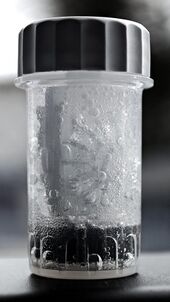
Hydrogen peroxide has various domestic uses, primarily as a cleaning and disinfecting agent.
- Hair bleaching
Diluted H
2O
2 (between 1.9% and 12%) mixed with aqueous ammonia has been used to bleach human hair. The chemical's bleaching property lends its name to the phrase "peroxide blonde".[80]
Hydrogen peroxide is also used for tooth whitening. It may be found in most whitening toothpastes. Hydrogen peroxide has shown positive results involving teeth lightness and chroma shade parameters.[81] It works by oxidizing colored pigments onto the enamel where the shade of the tooth may become lighter.[further explanation needed] Hydrogen peroxide may be mixed with baking soda and salt to make a homemade toothpaste.[82]
- Removal of blood stains
Hydrogen peroxide reacts with blood as a bleaching agent, and so if a blood stain is fresh, or not too old, liberal application of hydrogen peroxide, if necessary in more than single application, will bleach the stain fully out. After about two minutes of the application, the blood should be firmly blotted out.[83][84]
- Acne treatment
Hydrogen peroxide may be used to treat acne,[85] although benzoyl peroxide is a more common treatment.
- Oral cleaning agent
The use of dilute hydrogen peroxide as a oral cleansing agent has been reviewed academically to determine its usefulness in treating gingivitis and plaque. Although there is a positive effect when compared with a placebo, it was concluded that chlorhexidine is a much more effective treatment.[86]
Niche uses

- Horticulture
Some horticulturists and users of hydroponics advocate the use of weak hydrogen peroxide solution in watering solutions. Its spontaneous decomposition releases oxygen that enhances a plant's root development and helps to treat root rot (cellular root death due to lack of oxygen) and a variety of other pests.[87][88]
For general watering concentrations around 0.1% is in use and this can be increased up to one percent for anti-fungal actions.[89] Tests show that plant foliage can safely tolerate concentrations up to 3%.[90]
- Fishkeeping
Hydrogen peroxide is used in aquaculture for controlling mortality caused by various microbes. In 2019, the U.S. FDA approved it for control of Saprolegniasis in all coldwater finfish and all fingerling and adult coolwater and warmwater finfish, for control of external columnaris disease in warm-water finfish, and for control of Gyrodactylus spp. in freshwater-reared salmonids.[91] Laboratory tests conducted by fish culturists have demonstrated that common household hydrogen peroxide may be used safely to provide oxygen for small fish. The hydrogen peroxide releases oxygen by decomposition when it is exposed to catalysts such as manganese dioxide.
- Removing yellowing from aged plastics
Hydrogen peroxide may be used in combination with a UV-light source to remove yellowing from white or light grey acrylonitrile butadiene styrene (ABS) plastics to partially or fully restore the original color. In the retrocomputing scene, this process is commonly referred to as retrobright.
Safety
Regulations vary, but low concentrations, such as 5%, are widely available and legal to buy for medical use. Most over-the-counter peroxide solutions are not suitable for ingestion. Higher concentrations may be considered hazardous and typically are accompanied by a safety data sheet (SDS). In high concentrations, hydrogen peroxide is an aggressive oxidizer and will corrode many materials, including human skin. In the presence of a reducing agent, high concentrations of H
2O
2 will react violently.[92]
While concentrations up to 35% produce only "white" oxygen bubbles in the skin (and some biting pain) that disappear with the blood within 30–45 minutes, concentrations of 98% dissolve paper. However, concentrations as low as 3% can be dangerous for the eye because of oxygen evolution within the eye.[93]
High-concentration hydrogen peroxide streams, typically above 40%, should be considered hazardous due to concentrated hydrogen peroxide's meeting the definition of a DOT oxidizer according to U.S. regulations, if released into the environment. The EPA Reportable Quantity (RQ) for D001 hazardous wastes is 100 pounds (45 kg), or approximately 10 US gallons (38 L), of concentrated hydrogen peroxide.
Hydrogen peroxide should be stored in a cool, dry, well-ventilated area and away from any flammable or combustible substances. It should be stored in a container composed of non-reactive materials such as stainless steel or glass (other materials including some plastics and aluminium alloys may also be suitable).[94] Because it breaks down quickly when exposed to light, it should be stored in an opaque container, and pharmaceutical formulations typically come in brown bottles that block light.[95]
Hydrogen peroxide, either in pure or diluted form, may pose several risks, the main one being that it forms explosive mixtures upon contact with organic compounds.[96] Distillation of hydrogen peroxide at normal pressures is highly dangerous. It is also corrosive, especially when concentrated, but even domestic-strength solutions may cause irritation to the eyes, mucous membranes, and skin.[97] Swallowing hydrogen peroxide solutions is particularly dangerous, as decomposition in the stomach releases large quantities of gas (ten times the volume of a 3% solution), leading to internal bloating. Inhaling over 10% can cause severe pulmonary irritation.[98]
With a significant vapour pressure (1.2 kPa at 50 °C),[99] hydrogen-peroxide vapour is potentially hazardous. According to U.S. NIOSH, the immediately dangerous to life and health (IDLH) limit is only 75 ppm.[100] The U.S. Occupational Safety and Health Administration (OSHA) has established a permissible exposure limit of 1.0 ppm calculated as an 8-hour time-weighted average (29 CFR 1910.1000, Table Z-1).[96] Hydrogen peroxide also has been classified by the American Conference of Governmental Industrial Hygienists (ACGIH) as a "known animal carcinogen, with unknown relevance on humans".[101] For workplaces where there is a risk of exposure to the hazardous concentrations of the vapours, continuous monitors for hydrogen peroxide should be used. Information on the hazards of hydrogen peroxide is available from OSHA[96] and from the ATSDR.[102]
Wound healing
Historically, hydrogen peroxide was used for disinfecting wounds, partly because of its low cost and prompt availability compared to other antiseptics.[103]
There is conflicting evidence on hydrogen peroxide's effect on wound healing. Some research finds benefit, while other research find delays and healing inhibition.[104] Its use for home treatment of wounds is generally not recommended.[105] 1.5–3% hydrogen peroxide is used as a disinfectant in dentistry, especially in endodotic treatments together with hypochlorite and chlorhexidin and 1–1.5% is also useful for treatment of inflammation of third molars (wisdom teeth).[106]
Use in alternative medicine
Practitioners of alternative medicine have advocated the use of hydrogen peroxide for various conditions, including emphysema, influenza, AIDS, and in particular cancer.[107] There is no evidence of effectiveness and in some cases it has proved fatal.[108][109][110][111]
Both the effectiveness and safety of hydrogen peroxide therapy is scientifically questionable. Hydrogen peroxide is produced by the immune system, but in a carefully controlled manner. Cells called phagocytes engulf pathogens and then use hydrogen peroxide to destroy them. The peroxide is toxic to both the cell and the pathogen and so is kept within a special compartment, called a phagosome. Free hydrogen peroxide will damage any tissue it encounters via oxidative stress, a process that also has been proposed as a cause of cancer.[112] Claims that hydrogen peroxide therapy increases cellular levels of oxygen have not been supported. The quantities administered would be expected to provide very little additional oxygen compared to that available from normal respiration. It is also difficult to raise the level of oxygen around cancer cells within a tumour, as the blood supply tends to be poor, a situation known as tumor hypoxia.
Large oral doses of hydrogen peroxide at a 3% concentration may cause irritation and blistering to the mouth, throat, and abdomen as well as abdominal pain, vomiting, and diarrhea.[108] Ingestion of hydrogen peroxide at concentrations of 35% or higher has been implicated as the cause of numerous gas embolism events resulting in hospitalisation. In these cases, hyperbaric oxygen therapy was used to treat the embolisms.[113]
Intravenous injection of hydrogen peroxide has been linked to several deaths.[114][110][111] The American Cancer Society states that "there is no scientific evidence that hydrogen peroxide is a safe, effective, or useful cancer treatment."[109] Furthermore, the therapy is not approved by the U.S. FDA.
Historical incidents
- On 16 July 1934, in Kummersdorf, Germany, a propellant tank containing an experimental monopropellant mixture consisting of hydrogen peroxide and ethanol exploded during a test, killing three people.[115]
- During the Second World War, doctors in German concentration camps experimented with the use of hydrogen peroxide injections in the killing of human subjects.[116]
- In December 1943, the pilot Josef Pöhs died after being exposed to the T-Stoff of his Messerschmitt Me 163.
- In June 1955, Royal Navy submarine HMS Sidon sank after leaking high-test peroxide in a torpedo caused it to explode in its tube, killing twelve crew members; a member of the rescue party also succumbed.
- In April 1992, an explosion occurred at the hydrogen peroxide plant at Jarrie in France, due to technical failure of the computerised control system and resulting in one fatality and wide destruction of the plant.[117]
- Several people received minor injuries after a hydrogen peroxide spill on board a Northwest Airlines flight from Orlando, Florida to Memphis, Tennessee on 28 October 1998.[118]
- The Russian submarine K-141 Kursk sailed to perform an exercise of firing dummy torpedoes at the Pyotr Velikiy, a Kirov-class battlecruiser. On 12 August 2000, at 11:28 local time (07:28 UTC), there was an explosion while preparing to fire the torpedoes. The only credible report to date is that this was due to the failure and explosion of one of the Kursk's hydrogen peroxide-fueled torpedoes. It is believed that HTP, a form of highly concentrated hydrogen peroxide used as propellant for the torpedo, seeped through its container, damaged either by rust or in the loading procedure on land where an incident involving one of the torpedoes accidentally touching ground went unreported. The vessel was lost with all hands.[119]
- On 15 August 2010, a spill of about 30 US gallons (110 L) of cleaning fluid occurred on the 54th floor of 1515 Broadway, in Times Square, New York City . The spill, which a spokesperson for the New York City Fire Department said was of hydrogen peroxide, shut down Broadway between West 42nd and West 48th streets as fire engines responded to the hazmat situation. There were no reported injuries.[120]
See also
- FOX reagent, used to measure levels of hydrogen peroxide in biological systems
- Hydrogen chalcogenide
- Retrobright, a process using hydrogen peroxide to restore yellowed Acrylonitrile butadiene styrene plastic
- Bis(trimethylsilyl) peroxide, an aprotic substitute
References
- ↑ "The behaviour of mixtures of hydrogen peroxide and water. Part 1.—Determination of the densities of mixtures of hydrogen peroxide and water". Transactions of the Faraday Society 48: 796–801. 1952. doi:10.1039/TF9524800796.
- ↑ "Hydrogen peroxide". https://www.chemsrc.com/en/cas/7722-84-1_584358.html.
- ↑ 3.0 3.1 3.2 3.3 NIOSH Pocket Guide to Chemical Hazards. "#0335". National Institute for Occupational Safety and Health (NIOSH). https://www.cdc.gov/niosh/npg/npgd0335.html.
- ↑ 4.0 4.1 4.2 "Hydrogen peroxide". Immediately Dangerous to Life and Health Concentrations (IDLH). National Institute for Occupational Safety and Health (NIOSH). https://www.cdc.gov/niosh/idlh/772841.html.
- ↑ 5.0 5.1 Inorganic Chemistry (2nd ed.). Pearson Prentice-Hall. 2005. pp. 443–44. ISBN 0130-39913-2.
- ↑ A Vertical Empire: The History of the UK Rocket launch and Space Programme, 1950–1971. Imperial College Press. 2001. ISBN 978-1-86094-268-6. https://books.google.com/books?id=AzoCJfTmRDsC. Retrieved 24 August 2020.
- ↑ Handbook of preparative inorganic chemistry. 1. Translation editing by Reed F. (2nd ed.). New York: Academic Press. 1963. p. 140. ISBN 978-0-12-126601-1.
- ↑ "Peroxosolvates: Formation Criteria, H2O2 Hydrogen Bonding, and Isomorphism with the Corresponding Hydrates". Crystal Growth & Design 17 (1): 214–220. 2017-01-04. doi:10.1021/acs.cgd.6b01449. ISSN 1528-7483.
- ↑ "The Infra-Red Spectrum of Hydrogen Peroxide". Journal of Chemical Physics 18 (1): 88. 1950. doi:10.1063/1.1747464. Bibcode: 1950JChPh..18...88G. https://authors.library.caltech.edu/11457/1/GIGjcp50.pdf. Retrieved 31 December 2018.
- ↑ "Molecular association and structure of hydrogen peroxide". Journal of Chemical Education 60 (5): 399–401. 1983. doi:10.1021/ed060p399. Bibcode: 1983JChEd..60..399G.
- ↑ "Internal-Rotation in Hydrogen Peroxide: The Far-Infrared Spectrum and the Determination of the Hindering Potential". The Journal of Chemical Physics 42 (6): 1931. 1965. doi:10.1063/1.1696228. Bibcode: 1965JChPh..42.1931H. https://deepblue.lib.umich.edu/bitstream/handle/2027.42/71115/JCPSA6-42-6-1931-1.pdf?sequence=2. Retrieved 9 April 2014.
- ↑ "The Life Story of Hydrogen Peroxide III: Chirality and Physical Effects at the Dawn of Life". Origins of Life and Evolution of the Biosphere 46 (1): 81–93. March 2016. doi:10.1007/s11084-015-9465-y. PMID 26399407. Bibcode: 2016OLEB...46...81B.
- ↑ Modern Physical Organic Chemistry. University Science. 2005. p. 122. ISBN 978-1-891389-31-3.
- ↑ "The crystal structure of hydrogen peroxide". Acta Crystallographica 4 (1): 15–20. 1 January 1951. doi:10.1107/S0365110X51000039. Bibcode: 1951AcCry...4...15A.
- ↑ "Hydrogen Peroxide Technical Library". https://www.h2o2.com/intro/FMC_MSDS_40_to_60.pdf.
- ↑ 16.0 16.1 "Wasserstoffperoxid in Umweltschutz und Synthese". Chemie in unserer Zeit 34 (3): 150. 2000. doi:10.1002/1521-3781(200006)34:3<150::AID-CIUZ150>3.0.CO;2-A.
- ↑ Special Report No. 10. Hydrogen Peroxide. OEL Criteria Document. CAS No. 7722-84-1. July 1996.
- ↑ "A fluorimetric assay for hydrogen peroxide, suitable for NAD(P)H-dependent superoxide generating redox systems". Analytical Biochemistry 218 (2): 309–313. May 1994. doi:10.1006/abio.1994.1183. PMID 8074285. https://zenodo.org/record/890715. Retrieved 1 July 2019.
- ↑ "Looking Back at the Early Stages of Redox Biology". Antioxidants 9 (12): 1254. December 2020. doi:10.3390/antiox9121254. PMID 33317108. "I checked Humboldt’s pertinent publication carefully, but was unable to find an unambiguous proof of this assumption; the description of the starting materials (“Alaun-Erden” or “schwere Erden”) were just too unprecise to understand what kind of chemical experiments he performed.".
- ↑ "Der tropfbar flüssige Sauerstoff, oder das oxygenierte Wasser" (in de). Annals of Physics 65–66 (1): 3. 1820. doi:10.1002/andp.18200640102. Bibcode: 1820AnP....64....1T. https://books.google.com/books?id=xwYAAAAAMAAJ&pg=PA3.
- ↑ "Observations sur des nouvelles combinaisons entre l'oxigène et divers acides". Annales de chimie et de physique. 2nd series 8: 306–312. 1818. https://books.google.com/books?id=-N43AAAAMAAJ&pg=PA306. Retrieved 9 February 2016.
- ↑ Hydrogen peroxide. McGraw-Hill Education. doi:10.1036/1097-8542.329200. https://www.accessscience.com/content/hydrogen-peroxide/329200. Retrieved 28 November 2018. "Hydrogen peroxide was discovered in 1818 by the French chemist Louis-Jacques Thenard, who named it eau oxygénée (oxygenated water).".
- ↑ 23.0 23.1 Applications of Hydrogen Peroxide and Derivatives. Royal Society of Chemistry. 1999. ISBN 978-0-85404-536-5.
- ↑ "Concentration und Destillation von Wasserstoffsuperoxyd" (in de). Berichte der Deutschen Chemischen Gesellschaft 27 (3): 3307–3312. October 1894. doi:10.1002/cber.189402703127. https://gallica.bnf.fr/ark:/12148/bpt6k90736r/f704.image.langEN. Retrieved 29 June 2014.
- ↑ "Sul peso molecolare e sul potere rifrangente dell' acqua ossigenata". Atti della Reale Accademia dei Lincei 1 (2): 19–24. 1892. https://books.google.com/books?id=Yk46AQAAMAAJ&pg=PA19.
Carrara's findings were confirmed by: W. R. Orndorff and John White (1893) "The molecular weight of hydrogen peroxide and of benzoyl peroxide," American Chemical Journal, 15 : 347–356. - ↑ See, for example:
- In 1882, Kingzett proposed as a structure H
2O=O. See: "On the activity of oxygen and the mode of formation of hydrogen dioxide". The Chemical News 46 (1192): 141–142. 29 September 1882. https://books.google.com/books?id=1OYEAAAAQAAJ&pg=RA1-PA141. Retrieved 9 February 2016. - In his 1922 textbook, Joseph Mellor considered three hypothetical molecular structures for hydrogen peroxide, admitting (p. 952): "... the constitution of this compound has not been yet established by unequivocal experiments". See: Joseph William Mellor, A Comprehensive Treatise on Inorganic and Theoretical Chemistry, vol. 1 (London, England: Longmans, Green and Co., 1922), p. 952–956.
- W. C. Schumb, C. N. Satterfield, and R. L. Wentworth (1 December 1953) "Report no. 43: Hydrogen peroxide, Part two" , Office of Naval Research, Contract No. N5ori-07819 On p. 178, the authors present six hypothetical models (including cis-trans isomers) for hydrogen peroxide's molecular structure. On p. 184, the present structure is considered almost certainly correct—although a small doubt remained. (Note: The report by Schumb et al. was reprinted as: W. C. Schumb, C. N. Satterfield, and R. L. Wentworth, Hydrogen Peroxide (New York, New York: Reinhold Publishing Corp. (American Chemical Society Monograph), 1955).)
- In 1882, Kingzett proposed as a structure H
- ↑ "The theory of the structure of hydrogen peroxide and hydrazine". Journal of Chemical Physics 2 (8): 492–498. 1934. doi:10.1063/1.1749518. Bibcode: 1934JChPh...2..492P.
- ↑ "A note on the structure of H2O2 and H4N2 with particular reference to electric moments and free rotation". Transactions of the Faraday Society 30: 898–902. 1934. doi:10.1039/tf934300898b.
- ↑ 29.0 29.1 "Applications of transition-metal catalysts to textile and wood-pulp bleaching". Angewandte Chemie 45 (2): 206–222. December 2005. doi:10.1002/anie.200500525. PMID 16342123. https://onlinelibrary.wiley.com/doi/10.1002/anie.200500525. Retrieved 14 February 2022.
- ↑ 30.0 30.1 30.2 "Hydrogen peroxide synthesis: an outlook beyond the anthraquinone process". Angewandte Chemie 45 (42): 6962–6984. October 2006. doi:10.1002/anie.200503779. PMID 17039551.
- ↑ H. Riedl and G. Pfleiderer, U.S. Patent 2,158,525 (2 October 1936 in the US, and 10 October 1935 in Germany) to I. G. Farbenindustrie, Germany
- ↑ "Preparing to manufacture hydrogen peroxide". https://www.idc-online.com/technical_references/pdfs/chemical_engineering/Preparing_to_Manufacture_Hydrogen_Peroxide.pdf.
- ↑ Modern Inorganic Chemistry. Longmans, Green and Co.. 1922. pp. 192–195. https://archive.org/details/b29807712.
- ↑ Noritaka Mizuno Gabriele Centi, Siglinda Perathoner, Salvatore Abate "Direct Synthesis of Hydrogen Peroxide: Recent Advances" in Modern Heterogeneous Oxidation Catalysis: Design, Reactions and Characterization 2009, Wiley-VCH. doi:10.1002/9783527627547.ch8
- ↑ "Switching off hydrogen peroxide hydrogenation in the direct synthesis process". Science 323 (5917): 1037–1041. February 2009. doi:10.1126/science.1168980. PMID 19229032. Bibcode: 2009Sci...323.1037E.
- ↑ Greenwood, Norman N.; Earnshaw, Alan (1997). Chemistry of the Elements (2nd ed.). Butterworth-Heinemann. p. 633-637. ISBN 978-0-08-037941-8.
- ↑ "Decomposition of Hydrogen Peroxide - Kinetics and Review of Chosen Catalysts". https://www.proakademia.eu/gfx/baza_wiedzy/461/nr_26_45-52_2_3.pdf.
- ↑ General Chemistry: Principles & Modern Applications (9th ed.). Prentice Hall. 2007. p. 606. ISBN 978-0-13-149330-8. https://archive.org/details/generalchemistry0000petr/page/606.
- ↑ "Mild and Selective Oxidation of Sulfur Compounds in Trifluoroethanol: Diphenyldisulfide and Methyl phenyl Sulfoxide". Org. Synth. 80: 184. 2003. doi:10.15227/orgsyn.080.0184.
- ↑ "A Selective, Convenient, and Efficient Conversion of Sulfides to Sulfoxides". Synthesis (2): 227–232. 2004. doi:10.1055/s-2004-44387.
- ↑ "Nucleophilic Reactivities of Bleach Reagents". Organic Letters 20 (10): 2816–2820. May 2018. doi:10.1021/acs.orglett.8b00645. PMID 29741385.
- ↑ Wong, Chun Ming; Wong, Kwun Hei; Chen, Xiao Dong (2008). "Glucose oxidase: Natural Occurrence, Function, Properties and Industrial Applications". Applied Microbiology and Biotechnology 78 (6): 927–938. doi:10.1007/s00253-008-1407-4. PMID 18330562.
- ↑ Löffler G. and Petrides, P. E. Physiologische Chemie. 4 ed., pp. 321–322, Springer, Berlin 1988, ISBN:3-540-18163-6 (in German)
- ↑ "Peroxisome diversity and evolution". Philosophical Transactions of the Royal Society of London. Series B, Biological Sciences 365 (1541): 765–773. March 2010. doi:10.1098/rstb.2009.0240. PMID 20124343.
- ↑ "Biochemistry of mammalian peroxisomes revisited". Annual Review of Biochemistry 75 (1): 295–332. 2006. doi:10.1146/annurev.biochem.74.082803.133329. PMID 16756494.
- ↑ (in German) Lehninger Biochemie. Springer. 2001. pp. 663–664. ISBN 3-540-41813-X. https://books.google.com/books?id=wuLQCAOtC4MC&pg=PA663.
- ↑ 47.0 47.1 Nelson, David; Cox, Michael; Lehninger, Albert L. and Cox, Michael M. Lehninger Biochemie, p. 932, Springer, 2001, ISBN:3-540-41813-X (in German)
- ↑ Riley, Edward P. et al. (ed.) Fetal Alcoholspectrum Disorder Fasd: Management and Policy Perspectives , Wiley-VCH, 2010, ISBN:3-527-32839-4 p. 112
- ↑ Löffler G. and Petrides, P. E. Physiologische Chemie. 4 ed., p. 288, Springer, Berlin 1988, ISBN:3-540-18163-6 (in German)
- ↑ 50.0 50.1 Halliwell B, Adhikary A, Dingfelder M, Dizdaroglu M . Hydroxyl radical is a significant player in oxidative DNA damage in vivo. Chem Soc Rev. 2021 Aug 7;50(15):8355-8360. doi: 10.1039/d1cs00044f. Epub 2021 Jun 15. PMID 34128512; PMCID: PMC8328964
- ↑ "Hydrogen peroxide: a metabolic by-product or a common mediator of ageing signals?". Nature Reviews. Molecular Cell Biology 8 (9): 722–728. September 2007. doi:10.1038/nrm2240. PMID 17700625.
- ↑ "Oxidative Stress-Induced Caspases are Regulated in Human Myeloid HL-60 Cells by Calcium Signal". Current Signal Transduction Therapy 5 (2): 181–186. 2010. doi:10.2174/157436210791112172.
- ↑ "Role of Calcium Signals on Hydrogen Peroxide-Induced Apoptosis in Human Myeloid HL-60 Cells". International Journal of Biomedical Science 5 (3): 246–256. September 2009. doi:10.59566/IJBS.2009.5246. PMID 23675144.
- ↑ "The bombardier beetle and its chemical explosion". Angewandte Chemie 73: 1–7. 1961. doi:10.1002/ange.19610730102.
- ↑ "The Bombardier Beetle Myth Exploded". Creation/Evolution 2 (1): 1–5. Winter 1981. https://ncse.com/cej/2/1/bombardier-beetle-myth-exploded. Retrieved 12 November 2017.
- ↑ "Bombardier Beetles and the Argument of Design". 30 May 2003. https://www.talkorigins.org/faqs/bombardier.html.
- ↑ "Hydrogen peroxide sensing and signaling". Molecular Cell 26 (1): 1–14. April 2007. doi:10.1016/j.molcel.2007.03.016. PMID 17434122.
- ↑ "Wie Pflanzen sich schützen, Helmholtz-Institute of Biochemical Plant Pathology (in German)" (in de). Helmholtz-Institute of Biochemical Plant Pathology. https://www.helmholtz-muenchen.de/biop/printversionen/pdf/aktuelles/pflanzenschuetzen_no.pdf.
- ↑ "Dual role of hydrogen peroxide in cancer: possible relevance to cancer chemoprevention and therapy". Cancer Letters 252 (1): 1–8. July 2007. doi:10.1016/j.canlet.2006.10.029. PMID 17150302.
- ↑ Klenk, Herbert; Götz, Peter H.; Siegmeier, Rainer; Mayr, Wilfried. "Ullmann's Encyclopedia of Industrial Chemistry". Ullmann's Encyclopedia of Industrial Chemistry. Weinheim: Wiley-VCH. doi:10.1002/14356007.a19_199.pub2.
- ↑ Chemical degradation methods for wastes and pollutants environmental and industrial applications. New York: M. Dekker. 2003. p. 165. ISBN 978-0-203-91255-3.
- ↑ "Advanced Oxidation Processes for Organic Contaminant Destruction Based on the Fenton Reaction and Related Chemistry". Critical Reviews in Environmental Science and Technology 36 (1): 1–84. January 2006. doi:10.1080/10643380500326564. Bibcode: 2006CREST..36....1P.
- ↑ "Degradation of chlorophenols by means of advanced oxidation processes: a general review". Applied Catalysis B: Environmental 47 (4): 219–256. February 2004. doi:10.1016/j.apcatb.2003.09.010.
- ↑ Ullmann's Encyclopedia of Industrial Chemistry. Weinheim: Wiley-VCH. 2007. doi:10.1002/14356007.a13_443.pub2. ISBN 978-3-527-30673-2.
- ↑ Handbook of disinfectants and antiseptics. New York: M. Dekker. 1996. p. 161. ISBN 978-0-8247-9524-5.
- ↑ "Disinfection and sterilization in health care facilities: what clinicians need to know". Clinical Infectious Diseases 39 (5): 702–709. September 2004. doi:10.1086/423182. PMID 15356786.
- ↑ "Airborne hydrogen peroxide for disinfection of the hospital environment and infection control: a systematic review". The Journal of Hospital Infection 78 (3): 171–177. July 2011. doi:10.1016/j.jhin.2010.12.006. PMID 21392848.
- ↑ "Chapter 9: Peroxygen compounds". Disinfection, sterilization, and preservation (5th ed.). Philadelphia: Lea & Febiger. 2000. pp. 185–204. ISBN 978-0-683-30740-5.
- ↑ 69.0 69.1 "Chemical Disinfectants - Disinfection & Sterilization Guidelines - Guidelines Library - Infection Control - CDC" (in en-us). 4 April 2019. https://www.cdc.gov/infectioncontrol/guidelines/disinfection/disinfection-methods/chemical.html#Hydrogen.
- ↑ "Antiseptics and disinfectants: activity, action, and resistance". Clinical Microbiology Reviews 12 (1): 147–179. January 1999. doi:10.1128/cmr.12.1.147. PMID 9880479.
- ↑ "Chapter 27: Chemical Sporicidal and Sporostatic Agents". Disinfection, sterilization, and preservation (5th ed.). Philadelphia: Lea & Febiger. 2000. pp. 529–543. ISBN 978-0-683-30740-5.
- ↑ "Sec. 184.1366 Hydrogen peroxide". U.S. Government Printing Office via GPO Access. 1 April 2001. https://a257.g.akamaitech.net/7/257/2422/04nov20031500/edocket.access.gpo.gov/cfr_2001/aprqtr/21cfr184.1366.htm.
- ↑ "System Trade Parameter Comparison of Monopropellants: Hydrogen Peroxide vs Hydrazine and Others". 42nd AIAA/ASME/SAE/ASEE Joint Propulsion Conference & Exhibit. Sacramento, California. 9–12 July 2006. https://www.hydrogen-peroxide.us/history-US-General-Kinetics/AIAA-2006-5236_hydrogen_peroxide_versus_hydrazine.pdf.
- ↑ "The Use of Hydrogen Peroxide for Propulsion and Power". General Kinetics, LLC. 19 June 1999. https://www.hydrogen-peroxide.us/uses-monoprop-steam-generation/AIAA-1999-2880_The_Use_of_Hydrogen_Peroxide_for_Propulsion_and_Power-pitch.pdf.
- ↑ "Polish civil rockets' development overview". 2021. https://www.researchgate.net/publication/355481109.
- ↑ "Nucleus: A Very Different Way to Launch into Space" (in en-US). https://www.nammo.com/story/a-very-different-way-to-launch-into-space/.
- ↑ "Peroxide Accident – Walter Web Site". Histarmar.com.ar. https://www.histarmar.com.ar/InfGral/SubmarinosAcc/Peroxide%20Accident%20-%20Walter%20Web%20Site.htm.
- ↑ "Homing Instincts". Jane's Navy Steam Generated by Catalytic Decomposition of 80–90% Hydrogen Peroxide Was Used for Driving the Turbopump Turbines of the V-2 Rockets, the X-15 Rocketplanes, the Early Centaur RL-10 Engines and is Still Used on Soyuz for That Purpose Today. International. November 1997. https://babriet.tripod.com/articles/art_hominginstinct.htm. Retrieved 12 May 2007.
- ↑ "Soyuz using hydrogen peroxide propellant". NASA. https://www.nasa.gov/mission_pages/station/structure/elements/soyuz/landing.html.
- ↑ Oxygen : the molecule that made the world (First issued in paperback, repr. ed.). Oxford: Oxford University Press. 2003. p. 117. ISBN 978-0-19-860783-0. https://books.google.com/books?id=ziVk6CI82WgC&q=peroxide+blond&pg=PA117. Retrieved 12 November 2020.
- ↑ "The effect of hydrogen peroxide concentration on the outcome of tooth whitening: an in vitro study" (in English). Journal of Dentistry 32 (4): 295–299. May 2004. doi:10.1016/j.jdent.2004.01.003. PMID 15053912.
- ↑ "Brushing Up on Gum Disease". FDA Consumer. https://www.fda.gov/bbs/topics/CONSUMER/CON00065.html.
- ↑ "How to remove blood stains from clothes and furniture". 14 November 2016. https://www.today.com/home/how-remove-blood-stains-clothes-furniture-t104470.
- ↑ "Dried Blood Stain Removal". Lovetoknow.com. https://cleaning.lovetoknow.com/Dried_Blood_Stain_Removal.
- ↑ "Skin tolerability and efficacy of combination therapy with hydrogen peroxide stabilized cream and adapalene gel in comparison with benzoyl peroxide cream and adapalene gel in common acne. A randomized, investigator-masked, controlled trial". The British Journal of Dermatology 151 (2): 481–484. August 2004. doi:10.1111/j.1365-2133.2004.06067.x. PMID 15327558.
- ↑ Muniz, Francisco Wilker Mustafa Gomes; Cavagni, Juliano; Langa, Gerson Pedro José; Stewart, Bernal; Malheiros, Zilson; Rösing, Cassiano Kuchenbecker (2020-10-31). "A Systematic Review of the Effect of Oral Rinsing with H2O2 on Clinical and Microbiological Parameters Related to Plaque, Gingivitis, and Microbes". International Journal of Dentistry 2020: 8841722. doi:10.1155/2020/8841722. ISSN 1687-8728. PMID 33178277.
- ↑ "Ways to use Hydrogen Peroxide in the Garden". https://www.using-hydrogen-peroxide.com/peroxide-garden.html.
- ↑ Oxygation Unlocks Yield Potentials of Crops in Oxygen-Limited Soil Environments. Advances in Agronomy. 88. 2005. pp. 313–377. doi:10.1016/S0065-2113(05)88008-3. ISBN 978-0-12-000786-8.
- ↑ "Hydrogen Peroxide for Plants and Garden.". 7 September 2019. https://www.gardeningdream.com/hydrogen-peroxide-for-plants-and-garden-how-much-hydrogen-peroxide-to-use-on-plants/.
- ↑ "Effect of hydrogen peroxide spraying on Hydrocotyle ranunculoides". https://edepot.wur.nl/180309.
- ↑ "FDA Approves Additional Indications for 35% PEROX-AID (hydrogen peroxide) for Use in Certain Finfish" (in en). 2019-07-26. https://www.fda.gov/animal-veterinary/cvm-updates/fda-approves-additional-indications-35-perox-aid-hydrogen-peroxide-use-certain-finfish/.
- ↑ "Hydrogen Peroxide Accidents and Incidents: What we can learn from history". NASA. https://ntrs.nasa.gov/archive/nasa/casi.ntrs.nasa.gov/20050217417.pdf.
- ↑ see Hans Marquardt, Lehrbuch der Toxikologie
- ↑ "Material Compatibility with Hydrogen Peroxide". https://www.ozoneservices.com/articles/004.htm.
- ↑ "Hydrogen Peroxide Mouthwash is it Safe?". https://www.hydrogenperoxidemouthwash.org/.
- ↑ 96.0 96.1 96.2 "Occupational Safety and Health Guideline for Hydrogen Peroxide". https://www.osha.gov/SLTC/healthguidelines/hydrogenperoxide/recognition.html.
- ↑ For example, see an "MSDS for a 3% peroxide solution". https://hazard.com/msds/mf/baker/baker/files/h4070.htm.
- ↑ H2O2 toxicity and dangers Agency for Toxic Substances and Disease Registry website
- ↑ CRC Handbook of Chemistry and Physics, 76th Ed, 1995–1996
- ↑ "CDC – Immediately Dangerous to Life or Health Concentrations (IDLH): Chemical Listing and Documentation of Revised IDLH Values – NIOSH Publications and Products". 25 October 2017. https://www.cdc.gov/niosh/idlh/intridl4.html.
- ↑ "Threshold Limit Values for Chemical Substances and Physical Agents & Biological Exposure Indices, ACGIH". https://www2.worksafebc.com/PDFs/regulation/exposure_limits.pdf.
- ↑ "ATSDR – Redirect – MMG: Hydrogen Peroxide". https://www.atsdr.cdc.gov/MHMI/mmg174.html.
- ↑ "Hydrogen peroxide disrupts scarless fetal wound repair". Wound Repair and Regeneration 13 (5): 513–519. 2005. doi:10.1111/j.1067-1927.2005.00072.x. PMID 16176460.
- ↑ "Hydrogen peroxide (H2O2): a review of its use in surgery". Wiener Medizinische Wochenschrift 169 (9–10): 222–225. June 2019. doi:10.1007/s10354-017-0610-2. PMID 29147868.
- ↑ "Cleveleand Clinic: What Is Hydrogen Peroxide Good For?". December 2021. https://health.clevelandclinic.org/what-is-hydrogen-peroxide-good-for/.
- ↑ see e.g. Detlev Heidemann, Endodontie, Urban&Fischer 2001
- ↑ Hydrogen peroxide : medical miracle. Atlanta, GA: Second Opinion Pub.. 1995. ISBN 978-1-885236-07-4.
- ↑ 108.0 108.1 Hydrogen Peroxide, 3%. 3. Hazards Identification Southeast Fisheries Science Center, daughter agency of NOAA.
- ↑ 109.0 109.1 "Questionable methods of cancer management: hydrogen peroxide and other 'hyperoxygenation' therapies". CA: A Cancer Journal for Clinicians 43 (1): 47–56. 1993. doi:10.3322/canjclin.43.1.47. PMID 8422605.
- ↑ 110.0 110.1 "Hydrogen Peroxide". 30 April 2006. https://www.snopes.com/medical/healthyself/peroxide.asp.
- ↑ 111.0 111.1 "Naturopath Sentenced For Injecting Teen With Hydrogen Peroxide – 7NEWS Denver". Thedenverchannel.com. 2006-03-27. https://www.thedenverchannel.com/news/naturopath-sentenced-for-injecting-teen-with-hydrogen-peroxide.
- ↑ "Oxidative stress and cancer: have we moved forward?". The Biochemical Journal 401 (1): 1–11. January 2007. doi:10.1042/BJ20061131. PMID 17150040.
- ↑ "Hydrogen peroxide ingestion associated with portal venous gas and treatment with hyperbaric oxygen: a case series and review of the literature". Clinical Toxicology 48 (6): 533–538. July 2010. doi:10.3109/15563650.2010.492526. PMID 20575671. https://pubmed.ncbi.nlm.nih.gov/20575671/. Retrieved 4 January 2022.
- ↑ "A Prescription for Death?". CBS News. 12 January 2005. https://www.cbsnews.com/stories/2005/01/12/60II/main666489.shtml.
- ↑ "Heeresversuchsstelle Kummersdorf" (in en-US). UrbEx - Forgotten & Abandoned. 2008-03-23. https://www.urbex.nl/heeresversuchsstelle-kummersdorf/.
- ↑ "The Nazi Doctors: Medical Killing and the Psychology of Genocide". Robert Jay Lifton. https://phdn.org/archives/holocaust-history.org/lifton/LiftonT257.shtml.
- ↑ "Explosion and fire in a hydrogen peroxide plant". ARIA. November 2007. https://www.aria.developpement-durable.gouv.fr/fiche_detaillee/3536_en/?lang=en.
- ↑ "Accident No: DCA-99-MZ-001". U.S. National Transportation Safety Board. https://www.ntsb.gov/investigations/AccidentReports/Reports/HZB0001.pdf.
- ↑ "The True Story of the Russian Kursk Submarine Disaster". 28 September 2018. https://www.popularmechanics.com/military/navy-ships/a23494010/kursk-submarine-disaster/.
- ↑ "Bleach Spill Shuts Part of Times Square". The New York Times. 16 August 2010. https://www.nytimes.com/2010/08/16/nyregion/16square.html.
Bibliography
- The Syntheses of Sulphones, Sulphoxides and Cyclic Sulphides. Chichester UK: John Wiley & Sons. 1994. pp. 112–6. ISBN 978-0-471-93970-2.
- Chemistry of the Elements (2nd ed.). Oxford UK: Butterworth-Heinemann. 1997. A great description of properties & chemistry of H
2O
2. - Advanced Organic Chemistry (4th ed.). New York: Wiley. 1992. p. 723.
- "Hydrogen Peroxide". Kirk-Othmer Encyclopedia of Chemical Technology. 13 (4th ed.). New York: Wiley. 1995. pp. 961–995.
External links
- Hydrogen Peroxide at The Periodic Table of Videos (University of Nottingham)
- Material Safety Data Sheet
- ATSDR Agency for Toxic Substances and Disease Registry FAQ
- International Chemical Safety Card 0164
- NIOSH Pocket Guide to Chemical Hazards
- Process flow sheet of Hydrogen Peroxide Production by anthrahydroquinone autoxidation
- Hydrogen Peroxide Handbook by Rocketdyne
- IR spectroscopic study J. Phys. Chem.
- Bleaching action of Hydrogen peroxide at YouTube
 |



